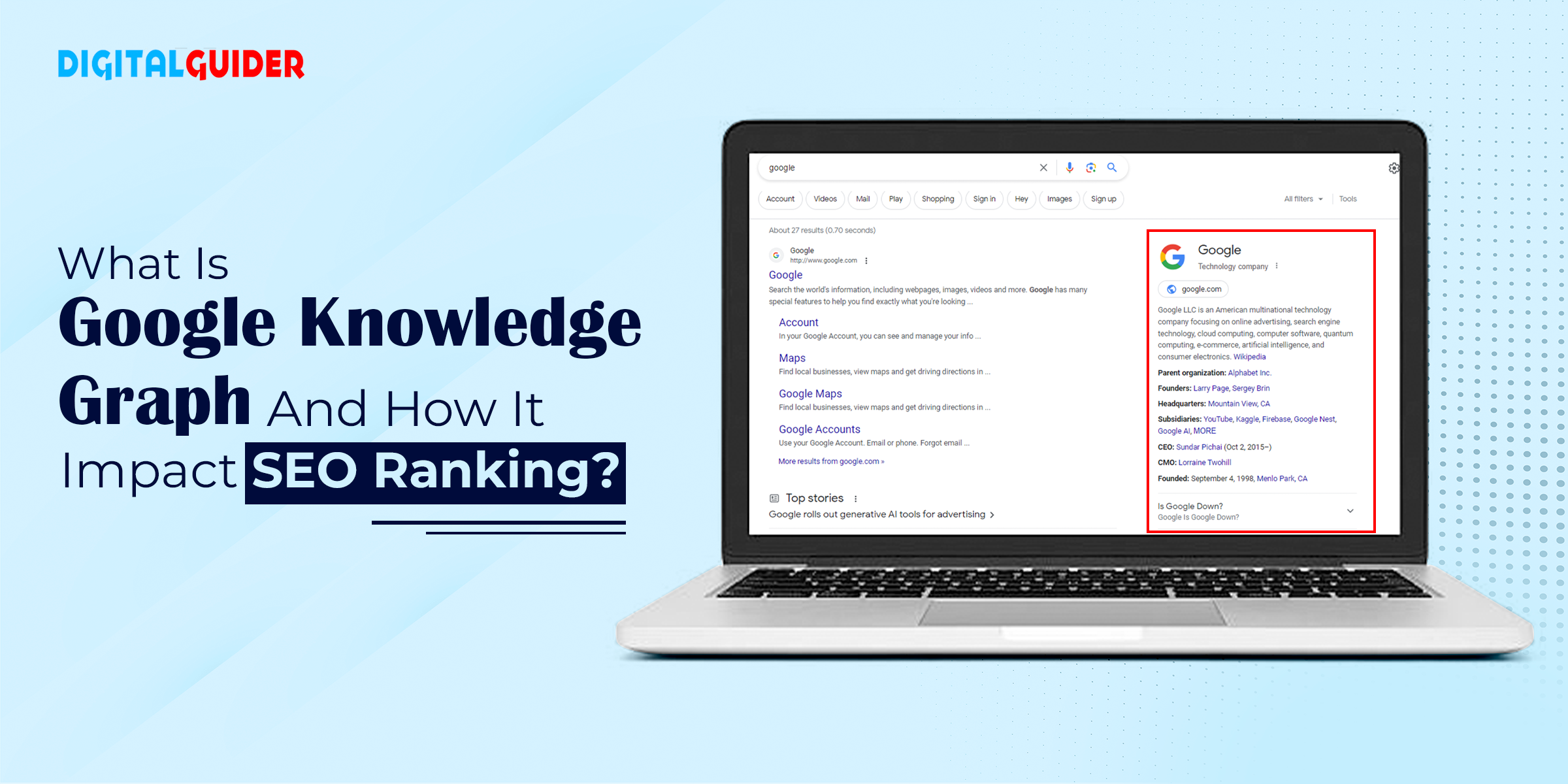Last Updated on December 6, 2023 by Stella Quinn
Have you ever searched for a famous movie or TV show and found yourself scrolling through multiple pages of search results, trying to find the information you need? Well, with Google’s Knowledge Graph, those days are gone.
Let’s say, you are searching for “F.R.I.E.N.D.S” The Knowledge Graph will present a wealth of information on the show, including its cast, seasons, plot summary, and related information. In the same way, you can also show up in the Google knowledge graph with the help of the right SEO assistance.
In this blog, we’ll explore what the Knowledge Graph is, how it works, its impact on Google Search & what it means to optimize your website for the Knowledge Graph.
What Is A Knowledge Graph In Google Search?
If you’ve ever Googled something and received a helpful & informative answer without clicking any other site given below, you likely have Google’s knowledge card to thank. Knowledge graph panels get prime featured spots in Google SERPs, giving searchers instant access to hyper-relevant information without clicking a link. Knowledge graph is one of the most popular types of zero search results.
The Knowledge Graph is an extensive database of interconnected information that Google uses to enhance search results as per user intent. It aims to provide concise, comprehensive, factual answers to users’ search queries about real-world topics by organizing data into meaningful entities and relationships.
Knowledge cards/graphs can help search engines like Google leverage structured data about topics. Topics aka. entities—like people, organizations, places, events, things, animals, foods, abstract notions, concepts, etc. Semantic data & markup help connect concepts and ideas, making it easier to turn them into structured data to increase Google’s Knowledge Graph.
Google Knowledge Graph Example
Let’s take a look at some real Google Knowledge Graph Examples that demonstrate the power of Knowledge Graph.
Imagine searching for “Top USA authors” Google’s Knowledge Graph will display a knowledge panel of the search results, presenting top USA authors with sources across the web.
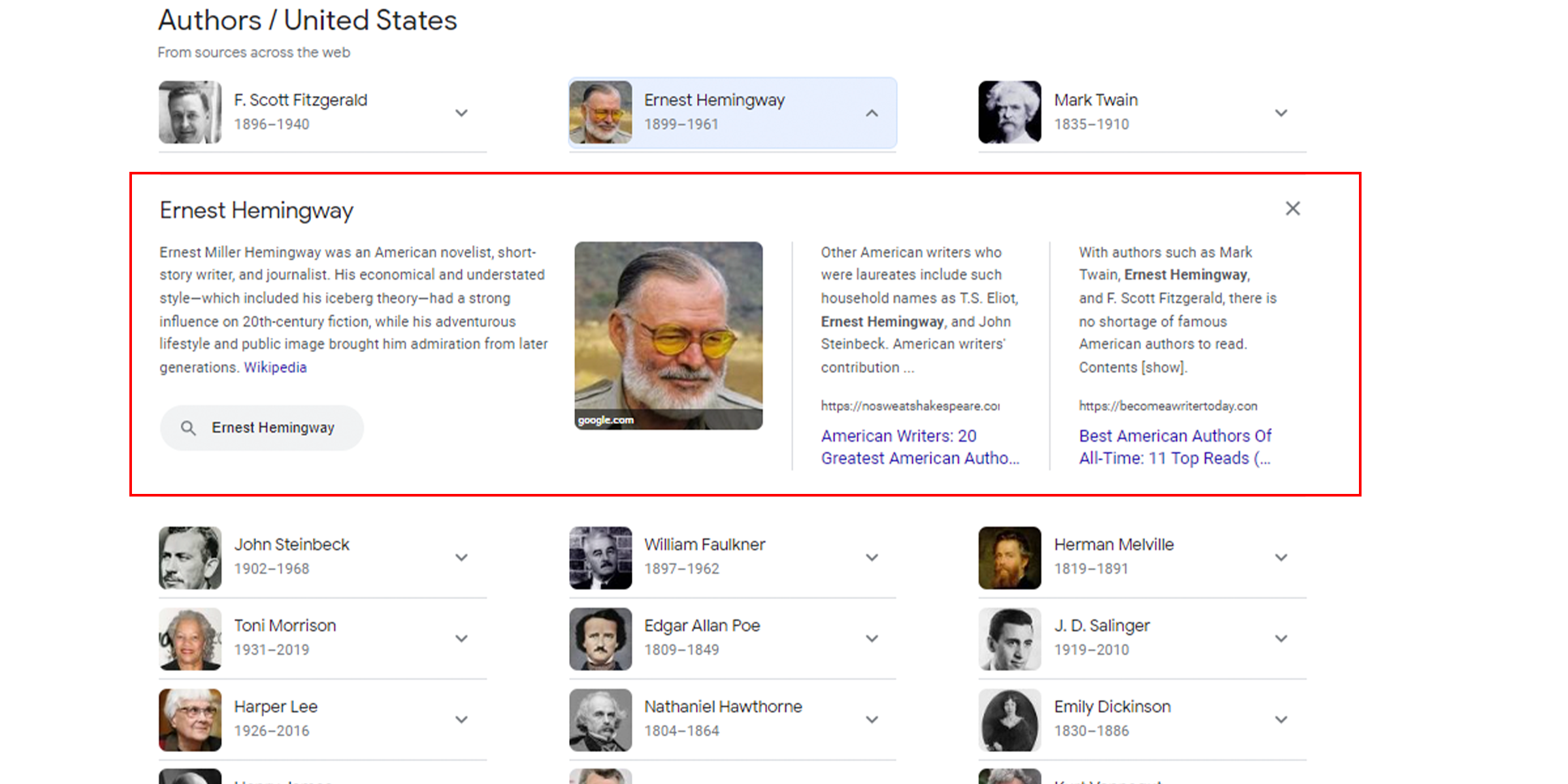
Then again, click one of the authors, let’s say, Ernest Hemingway, then there comes a brief overview of the artist’s life overview, books, short stories, videos, fiction, notable works, and related information. This provides users with relevant details at a glance.
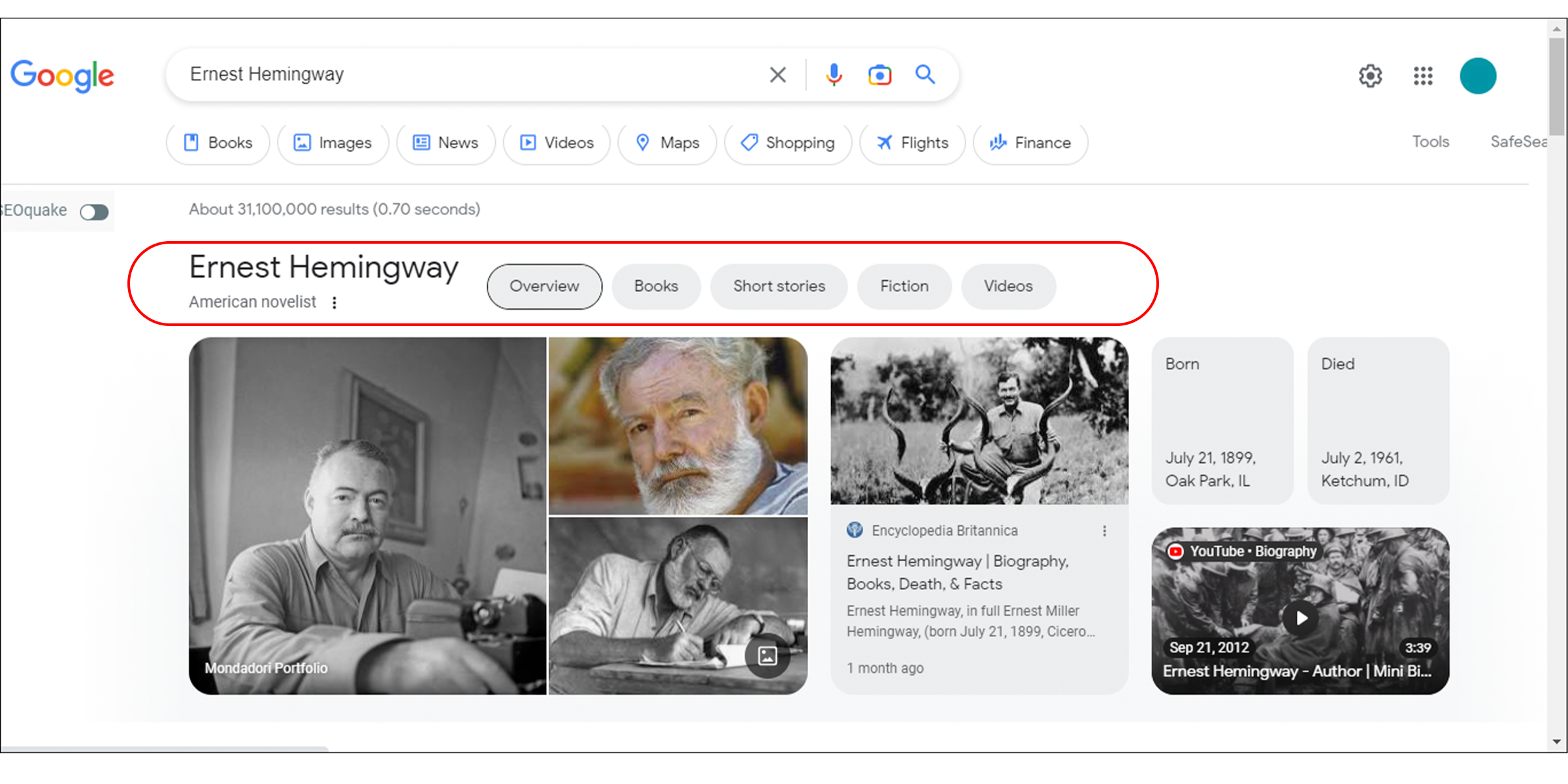
This search provides more than just standard search results with links to other websites. Instead, it summarizes the basic information about the author, his books, and other relevant media. All of this is part of Google’s Knowledge Graph.
Another example of Google knowledge graph is if we want to see a film’s cast (Fast X), Google can display this in a carousel format on the search results page.
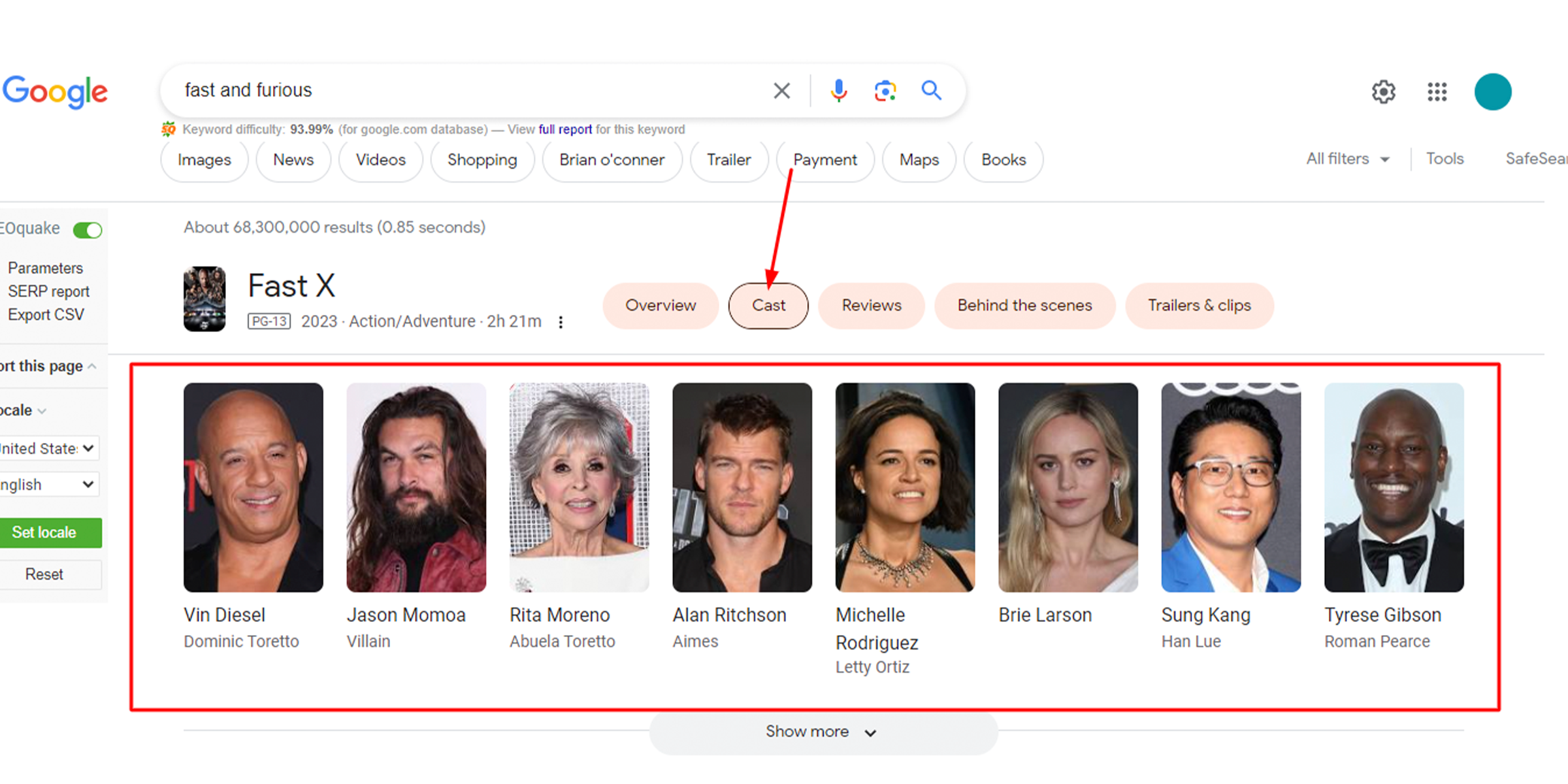
Anatomy of the Knowledge Graph
Google introduced the knowledge card/graph 2012 to help searchers discover new information quicker. They made an excellent introductory video. This explains in easy-to-understand language how exactly the graph works and how it influences the results you get whenever you search for any specific topic/term/people. Check out the video; it is still as relevant today as it was then:
What Are The Benefits Of Using Google Knowledge Graph?
Most people need to know the usefulness of Google knowledge graph for business. You can leverage these benefits in many ways. Below are some benefits of Google’s knowledge graph that will compel you to use it immediately.
1- It offers basic business information:
The main job of search engine bots/crawlers is to provide answers to people’s queries. People are technology and internet driven these days, and search engines are the only way they look for their queries. In that case, if you provide your content effectively, you can show up there.
2- Helps in building trust with potential site visitors:
Trust is the most essential thing that your website requires to excel in the internet world. If your site can populate the knowledge card, your chance of getting more user attention increases, eventually leading to more profits.
3- Help brands become more visible in search results:
Google knowledge graph for business helps you build authority for specific topics. Structured data on websites can influence data pulled into the Knowledge Graph.
4- It assures users of a relevant and good experience:
Your website must look good, or its on-site structure should be attractive enough for people to stick to it. So knowledge graph helps you in doing so, which gives users a given experience, and ultimately, you will attract potential viewers and customers.
Customer requires the right business that gives them satisfaction for their investment. Communication is crucial to building more networks. Therefore, when it comes to building network knowledge graphs could be a good option. It will also help you in increasing your social media followers & engagement.
6- Give credibility to your business by displaying reviews and ratings:
High ratings and stars are the primary driving force for increasing traffic to your website. People get attracted to a website that has good reviews. It helps you boost your brand reputation.
7- Makes it easy to contact customers or viewers:
Keeping contact is one hectic task. Checking calls, Emails, and websites takes a lot of effort and patience. So Google’s knowledge graph makes it easy to contact customers or viewers. Connecting is much easier and simpler with a Google search knowledge graph.
8- Allow you to add your reviews with a single click:
Google knowledge graph SEO makes adding new reviews easier, which took logging in and navigating earlier. Now you can add your reviews with a single click.
How Does Google Knowledge Graph Impact SEO Ranking? What Tips To Apply?
The Knowledge Graph gives users speedy and clear answers to their questions. It plays a powerful role in SEO rankings factors by directly providing users with rich, relevant, and structured information on the SERP. Here are ten points explaining how the Knowledge Graph can impact SEO rankings:

1. Enhanced Visibility:
If your business has a knowledge panel, you get increased website visibility in SERPs by displaying relevant information about it directly in the search results, improving the website’s CTR. Whenever a user searches for a specific term/topic, the Knowledge Graph provides a brief topic summary, key details about that entity, and images from one particular website that increases the chances of users clicking through to the website.
Pro Tip: Create informative and well-structured content to enhance visibility through the knowledge card. Consider using schema markup like, organization schema markup, FAQ schema markup, local business schema markup, etc., to provide search engines with specific data about your website’s entities. Aim to become an authoritative source in your industry to increase the chances of being included in the Knowledge Graph.
2. Knowledge Panel Presence:
A website that appears in the Knowledge Graph’s Knowledge Panel gains increased prominence, establishing it as an authoritative source in its field. The Knowledge Panel appears prominently on the right-hand side of the SERP and provides complete information about a specific brand. This presence boosts visibility and establishes that brand website as a trustworthy source.
Pro Tip: Optimize your GMB listing & ensure that your business information, such as contact details, address, and opening hours, is accurate and up to date. Give as much detailed information as possible about your products, services, and brand to increase the likelihood of being featured in the Knowledge Panel. Encourage customers to give reviews and respond to them promptly.
3. Brand Authority:
By appearing in the Knowledge Graph, a website can enhance its brand authority and credibility as Google only selects trusted and reputable sources to populate the Google search knowledge graph, so being featured in it signifies that the website is recognized as a reliable and authoritative resource.
Pro Tip: Publish authoritative articles, guides, and resources related to your industry. Collaborate with influencers or industry experts for endorsements or contributions. Earn backlinks from reputable websites and engage in thought leadership activities like speaking at conferences or publishing research papers.
4. Rich Snippets:
The Knowledge Graph provides data for rich snippets and structured snippets of the information displayed within topic search results. Rich snippets enhance a website’s visibility by offering additional details such as ratings, reviews, event information, etc., and attract more users. These snippets attract users’ attention, increasing the likelihood of clicks and driving traffic to the website.
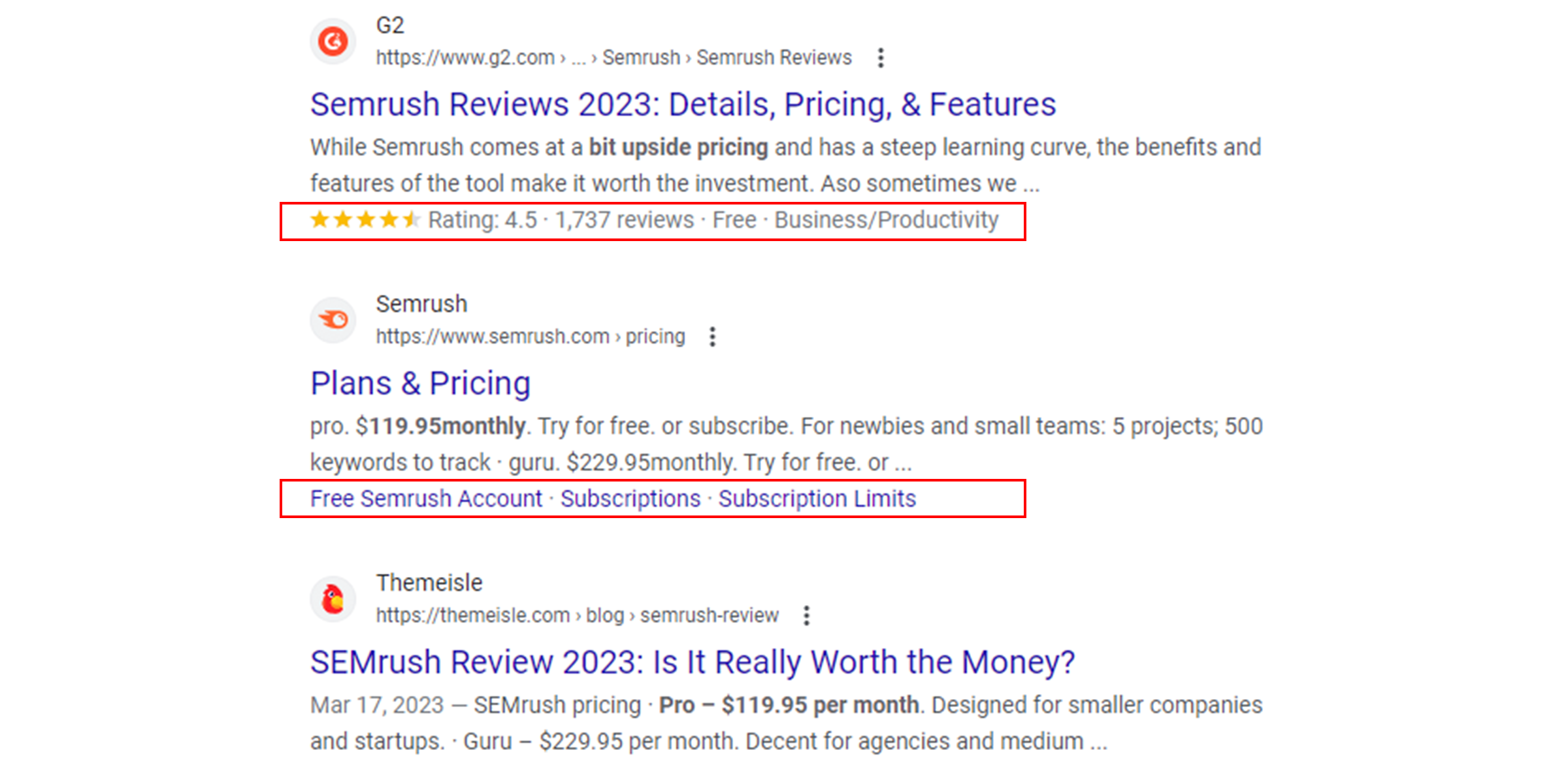
Pro Tip: Use tools like Google’s Structured Data Testing Tool to validate your markup and ensure it is correctly implemented. This can include reviews, ratings, product details, event information, recipes, and more.
5. Answer Box Placement:
Websites featured in the Google search knowledge graph have a higher chance of appearing in the answer box, also known as the “position zero” spot, which drives significant organic traffic.
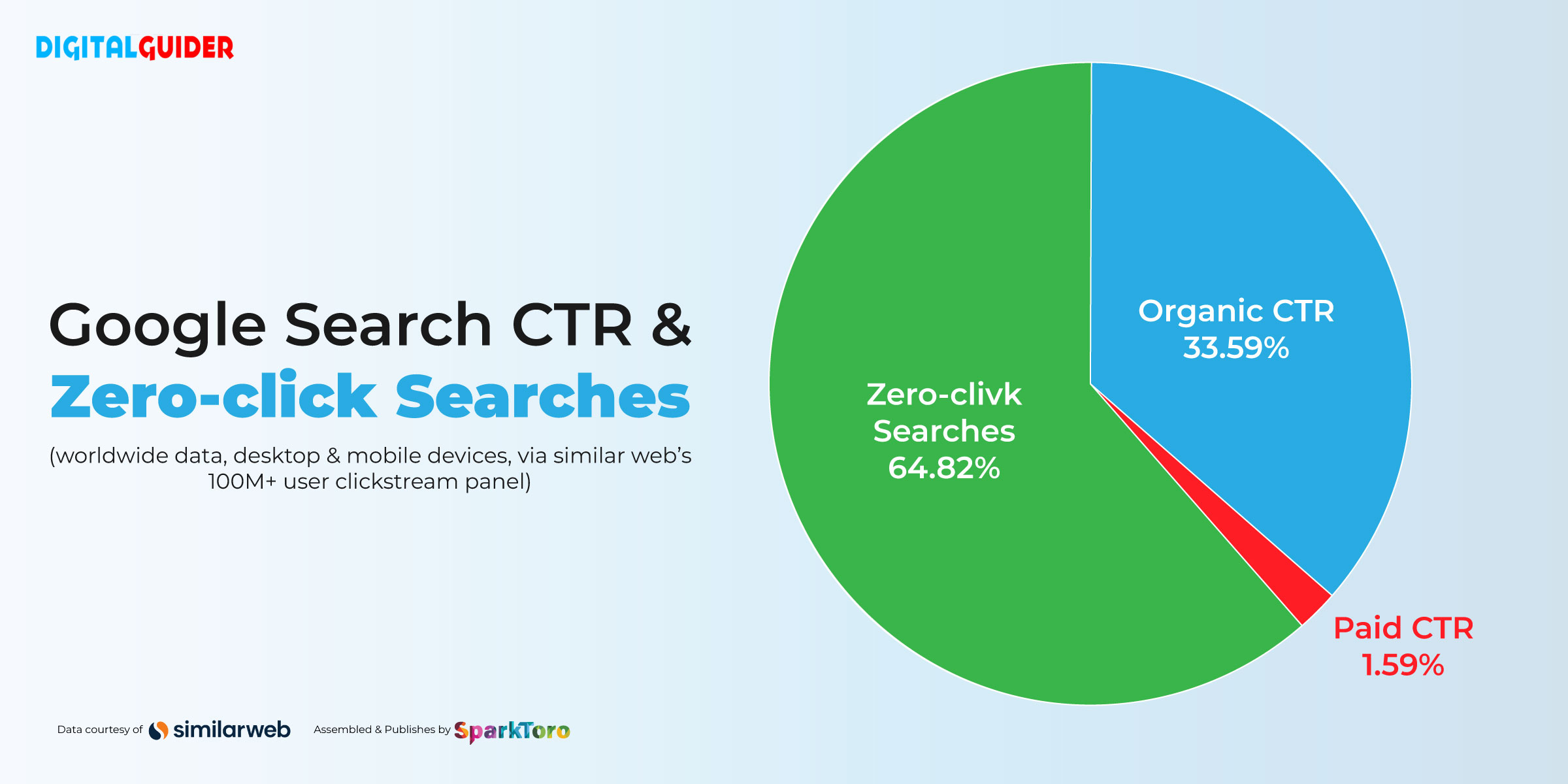
Nearly 75% of Google searches ended without a click to another web property — up from 50%, according to a SimilarWeb study. As Google offers answers to users directly on its results pages, zero-click searches have increased. Zero-click searches don’t end up with a user clicking one of the search results.
Pro Tip: Optimize your content to amplify content’s reach and provide concise, accurate answers to common user queries. Structure your content in a way that is easily scannable by search engines. Utilize headers, bullet points, and clear sections to structure your information effectively. Research commonly asked questions in your industry and provide comprehensive answers within your content.
6. Semantic Relevance:
The Knowledge Graph relies on semantic search, understanding the context and meaning behind search queries. It goes beyond keyword matching and considers the relationship between entities. Websites that align with the semantic relevance of a query have a better chance of ranking higher in SERP results. Optimizing content to be semantically relevant can improve visibility and attract targeted traffic.
Pro Tip: Create content that covers a broad range of topics related to your industry or niche. Conduct keyword research to identify semantic variations and related terms. Focus on providing comprehensive information and answering user intent rather than just targeting specific keywords.
7. Increased User Engagement:
Knowledge Panels and rich snippets offer users immediate access to valuable information, reducing the need to click through to a website. However, if users find the displayed helpful information, the chances of them visiting your website is more, boosting engagement metrics. This increased engagement signals to search engines that the website provides valuable content, which can positively impact rankings.
Pro Tip: Create compelling meta titles and descriptions that entice users to click through your website. Ensure your website loads quickly and use engaging visuals, such as images and videos, to enhance the user experience. Incorporate a clear CTA to encourage users to explore your website further.
8. Local Search Optimization:
The Knowledge Graph incorporates information from various local directories and platforms, making it important for businesses targeting local search results. Accurate and consistent information about a business’s (NAP) name, address, phone number, and other details help improve local SEO rankings. Being included in the Knowledge Graph can enhance a business’s visibility in local search and attract relevant local traffic.
Pro Tip: Local SEO will help you optimize your website for local search by including NAP consistently across all online directories and platforms. Encourage customer reviews on platforms like GMB. Create location-specific landing pages (with local keywords in your content & meta tags) if your business has multiple locations.
Also read: What is Hyperlocal Marketing Strategy – Boost Your Business Locally
9. Semantic Relationships:
Google uses semantic search and the relationships between things in the Knowledge Graph to show what it sees as the most important data in a panel (known as a Knowledge panel) on the right side of the search results.
It establishes semantic relationships between entities, helping Google understand the relationships between different topics, industries, and entities. Websites well-connected within the Google search knowledge graph have a better chance of ranking higher.
Pro Tip: Identify relevant entities within your niche. Create content that establishes clear connections & provides valuable information on these topics. Utilize internal & cross-linking to connect related content on your website. Aim to be linked to other authoritative websites in your niche to strengthen semantic relationships.
10. Voice Search Optimization:
With the rise of voice search, the Knowledge Graph becomes even more critical. Voice assistants, for example, Google Assistant, rely on the Knowledge Graph to provide concise and accurate answers to user queries, making optimization for voice search crucial for SEO success.
Optimizing content for voice search, including structured data and relevant information, increases the likelihood of being featured in voice search results and can drive significant organic traffic to a website.
Pro Tip: Ensure your website is mobile-friendly and loads quickly, as voice search is often performed on mobile devices. Anticipate user questions and structure your content to address them. Incorporate long-tail and conversational keywords naturally within your content.
Final thoughts:
Remember that while the Google search knowledge graph can impact SEO rankings, it’s just one aspect of an effective SEO strategy. High-quality content, website structure, backlinks, and user experience are vital for higher rankings.
Implementing above mention strategies requires a comprehensive approach to SEO. Keep up to date with the latest SEO practices and algorithm changes so you can adjust your tactics accordingly. Regularly monitor your website’s performance, analyze data, and adjust as needed to optimize for the Knowledge Graph and overall SEO success.
If you don’t have SEO expertise, things can take a little longer for you. But don’t worry; we are here to help. Digital Guider’s SEO services will help you increase your chances of getting featured in SERP quickly. Our content marketing services will help you create structured, engaging, and SEO-optimized content for your business blogs and website.
Call us now at +1-307-209-3608 or book a free consultation call now.
Google Knowledge Graph FAQ
How does the Knowledge Graph work?
To populate the Google search knowledge graph, Google gathers data from various trusted sources, including Wikipedia, official websites, and structured data markup on web pages. It employs advanced algorithm techniques to organize information, creating a comprehensive network of entities and relationships.
What are the benefits of the Knowledge Graph?
The Knowledge Graph enriches search results by providing immediate answers, improving search relevance, and offering a more interactive experience. It lets users find information quickly without clicking through multiple search results.
Can my business benefit from the Knowledge Graph?
Absolutely! By optimizing your site & content, you can increase your online visibility, establish your brand as an authoritative source, and drive organic traffic to your website, boosting your online presence & attract potential customers.
How can an SEO agency help me leverage the Knowledge Graph?
An experienced SEO agency understands the strategic workings of the Google knowledge graph for business and can implement effective strategies to optimize your website's chances of appearing in it. Digital Guider can help you with structured data markup, content optimization, and overall SEO best practices to improve your chances of being featured prominently.
What is structured data markup, and why is it important?
Structured data markup is a standardized format that helps search engine bots better understand your site's context. Provide clear signals to Google about your website's elements, such as products, events, reviews, and more.
How long does appearing in the Knowledge Graph take?
The timeline for appearing in the Google search knowledge graph varies depending on several factors, such as the relevance and popularity of your content, the overall authority of your website & the accuracy of your structured data markup. Using the right SEO strategies, an SEO company can help you get your website out there faster and give you a better chance of getting noticed.
Can an SEO agency improve my chances of appearing in the Knowledge Panel?
Yes, an SEO agency can help optimize your online presence to increase your chances of appearing in the Knowledge Panel. Implementing targeted SEO strategies, such as website authority building, content optimization, and online reputation, can improve your visibility, increasing the likelihood of being featured.
